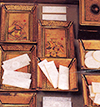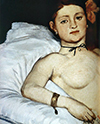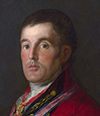| |
| |
HISTORY AND PAINTING
This week a major new exhibition opens at the Musée d'Orsay in Paris focusing on representations of the shady world of prostitution during the second half of the 19th century. Changes in the makeup of the city and developments within society during the Second Empire rendered prostitutes more “visible”. However, the fact that these women became such a part of the landscape has meant that viewers of today (bathed as they are in Impressionist art) have failed to spot this underlying aspect so frequently portrayed by artists in the 19th and early 20th century. After that we bring you Thomas Crow and his fascinating series of lectures for the National Gallery of Art in Washington in which he explores how art and politics were fundamentally intertwined in the period before and after the fall of the First Empire. The formal art of both the First and Second Empires can therefore be really valuable as a guide to the complexities of history.
In the same way, real wounds, real pain, can be perceived in the very painterly watercolours made by the surgeon Charles Bell (1774-1842) of wounded soldiers from the battle of Waterloo. The artistic medium of painting was used by Bell in a very technical way to record the injuries sustained during warfare, and indeed some of the illustrations were later used for teaching purposes.
As we look at these relatively “objective” representations today, they provide a glimpse of the reality of the human tragedy of such events.
The art of yesteryear may sometimes seem distant, but put into context with our sight guided by commentary and scholarly exhibitions they can provide thought provoking and emotionally charged lessons in how the past really felt.
Enjoy your read on napoleon.org.
Rebecca Young
Web editor for Napoleon.org/en

|
|
|
| |
OBJECT OF THE MONTH > DELUXE ACCOUTREMENTS FOR THE CARD GAME, L'HOMBRE
Napoleon did not play Poker, but rather a 17th-century Spanish game called “l'Hombre” (pronounced "lomber" meaning “man”), considered to be the ancestor of Bridge. It was played by three players, two of whom were traditionally female and the other a man (hence the name). According to Barry O'Meara*, Napoleon's doctor on St Helena up to 1818, the Emperor was in posession of this set on St Helena which he greatly admired.
*TO READ ONLINE > O'Meara, Barry Edward, (1786-1836) Napoleon in exile; or, A voice from St. Helena. The opinions and reflections of Napoleon on the most important events of his life and government in his own words, first published in 1822.

|
|
|
| |
NEW EXHIBITION > SPLENDEURS ET MISERES: IMAGES DE LA PROSTITUTION, 1850-1910 (SPLENDOUR AND MISERY: PICTURES OF PROSTITUTION)
A new exhibition at the Musée d'Orsay explores the shady world of prostitution in the latter half of the 19th century and how it was intricately intertwined with the development of modern painting. This is the first time a major exhibition in France has treated this fascinating subject. The Museum is also presenting a program of concerts and opera on film. There is also a catalogue published in English, and all the online texts are available in English. (until 17 January 2015).
ARTICLE > COURTESANS AND STREET WALKERS: PROSTITUTES IN ART
Jason Farago writes in a recent article (external link) for the BBC, “prostitution was a central part of daily life in late 19th-century Paris. It is key to understanding the art of the times – and everything that followed”.
FOCUS ON > THE SO-CALLED "LA PAÏVA" BED
When brothels were finally banned in France in 1946 the contents of a famous townhouse "designed for a very particular use" were said to have included an elaborately sculpted bed known as “La Païva”, including the figure of Venus which was said to be modelled on the Marquise de la Païva, a courtesan born into poverty in 1819 in the Jewish ghetto in Moscow. In France she used her beauty to devour fortune after fortune, thus becoming one of the scandalous queens of charm during the Second Empire. Read more about this infamous bed.

|
|
|
| |
BATTLEFIELD SURGERY > WATERCOLOURS FROM WATERLOO
This is one of a series of watercolours of wounded soldiers from the battle of Waterloo by the surgeon Charles Bell (1774-1842). Bell had hurried from London to Brussels in June 1815 to assist in treating the wounded. At the same time he filled a sketchbook with interesting cases, which he subsequently worked up as watercolour paintings for teaching purposes. We know from later reports sent to Bell by the surgeon left in charge after the former returned to London that the patient pictured here made a good recovery. However the anatomist Robert Knox commented very negatively on Bell's surgical abilities; the mortality rate of amputations carried out by Bell ran at about 90%. See the whole album (external link) on the website of the Wellcome Foundation.
> LARREY'S MEMOIRS OF MILITARY SURGERY
"I salute the courage and devotion of an age which is no longer ours". This was how the Duke of Wellington praised the courage of Baron Dominique-Jean Larrey, surgeon-in-chief of the Imperial Guard who gathered the injured, regardless of rank or nationality, at the Belle Alliance and operated on them after the terrible day of fighting at Waterloo. The first volume of Larrey's memoirs of the Napoleonic Campaigns (translated into English by Richard Willmott Hall) can be read online here (external link).

|
|
|
| |
ONLINE LECTURES > RESTORATION AS EVENT AND IDEA: ART IN EUROPE, 1814‒1820
In this first of a series of six lectures originally given at the National Gallery of Art in Washington, entitled “Moscow Burns / The Pope Comes Home, 1812‒1814: David, Gros, and Ingres Test Empire's Façade”, Professor Thomas Crow describes how key works by David, Gros, and Ingres, fashioned during this tumultuous two-year period, convey the tensions and fissures engendered by the unsustainable character of Napoleon's foundering empire. The lecture lasts approximately one hour (external link).
LAST DAYS > REMEMBERING NAPOLEON BONAPARTE (University of Delaware Library, Newark, USA)
“Remembering Napoleon Bonaparte” features several images and artifacts from the Frank W. Tober papers and the Marshals of Napoleon collection, both of which are part of University of Delaware Library Special Collections. (until 2 0ctober).

|
|
|
| |
THEATRE > THE DUKE IN THE CUPBOARD
On 2 August, 1961 Goya's portrait of the Duke of Wellington (pictured), having been saved for the British nation with a special treasury grant, was put on display at the National Gallery in London, only to be stolen 19 days later. "The Duke in the Cupboard" is a new play by Susan Wear who spent two years researching the case. It will be performed at the Customs House, South Shields (UK) from Wednesday, 7 October to Saturday, 10 October.
Find out more on how Goya's Duke was stolen in this article from the Guardian.
LAST DAYS > EXHIBITION NAPOLEON AND POWYS (UNTIL 30 SEPTEMBER)
This exhibition at the Judge's Lodging, (Presteigne, Powys, UK) focusing on the effects of the Napoleonic Wars in this area of Wales bringing together for the first time objects from museums and private collections throughout Powys.
Wishing you an excellent Napoleonic week!
Peter Hicks and Rebecca Young
THE NAPOLEON.ORG BULLETIN No. 771, 25 SEPTEMBER - 1 OCTOBER, 2015
Interested in the work of the Fondation Napoléon? Why not participate, either generally or in a specific project, by making a donation?
© This Napoleon.org weekly bulletin is published by the Fondation Napoléon. Reproduction or all or part of this bulletin is forbidden, without prior agreement of the Fondation Napoléon

|
|
|
|
|
|
|
|
WATERLOO BICENTENARY 1815-2015
What's on this year relating to the Bicentenary of the Battle of Waterloo: commemorations, books, exhibitions, news ...
Follow us on our new English-language Facebook page and on Twitter!
napoleon.org - related content:
WHAT'S ON (see our website for all events)
Conferences
- Waterloo, 1815: The British Monarchy and the Defeat of Napoleon Windsor, UK [14/11/2015]
Exhibitions
- Splendeurs et misères. Images de la prostitution, 1850-1910 (Splendour and Misery. Pictures of Prostitution) Musée d'Orsay, Paris, France [22/09/2015 - 17/01/2016] NEW
- Élisabeth Louise Vigée-Lebrun (1755-1842) Grand Palais, Paris, France [23/09/2015 - 11/01/2016]
- Le Bivouac de Napoléon : luxe et ingéniosité en campagne Galerie des Gobelins, Paris [18/09/2015 - 13/12/2015]
- Daniel Maclise: The Waterloo Cartoon Royal Academy of Arts (UK) [02/09/2015 - 03/01/2016]
- Murat, King of Naples, at the charge! Palazzo Reale, Naples, Italy [19/05/2015 - 19/10/2015]
- Dancing into Battle: The Duchess of Richmond's Ball, Goodwood House, Sussex (UK) [03/08/2015 - 11/10/2015]
- Remembering Napoleon Bonaparte, University of Delaware Library, Newark, USA [03/08/2015 - 02/10/2015] LAST DAYS
- Fallen Emperor: Napoleon in Plymouth Sound in 1815, Plymouth City Museum and Art Gallery, UK [23/05/2015 - 26/09/2015] LAST DAYS
- Pierre-Paul Prud'hon: Napoleon's Draughtsman Dulwich Picture Gallery, London, UK [23/06/2015 - 15/11/2015]
- 'Waterloo and the March of Science', Herschel Museum of Astronomy, Bath, UK [18/06/2015 - 13/12/2015]
- '"Victory Sir, Victory!" Henry Percy and the Battle of Waterloo, 1815', Alnwick Castle, Northumberland, UK [18/05/2015 - 30/10/2015] LAST DAYS
- 'The Road to Waterloo' and ‘Waterloo Lives' Gordon Highlanders Museum, Aberdeen, Scotland [03/02/2015 - 28/11/2015]
- 'Waterloo' at the Bomann-Museum, Celle, Germany [02/04/2015 - 11/10/2015] LAST DAYS
- 'Napoleon und Bayern' Bayerisches Armeemuseum, Ingolstadt, Germany [30/04/2015 - 30/10/2015]
- 'Waterloo 1815 - The Battle for Peace' at Wellington Arch and new display at Apsley House London UK [18/04/2015 - 30/12/2015]
'Alexander, Napoleon and Josephine: a story of war, art and friendship' Hermitage, Amsterdam, The Netherlands [28/03/2015 - 08/11/2015]
THE BIBLIOTHÈQUE MARTIAL-LAPEYRE FONDATION NAPOLEON LIBRARY
The library is normally open on Mondays and Tuesdays from 1pm to 6pm and on Thursdays and Fridays from 10am to 3pm. The library is closed on Wednesdays.
Online database catalogue
Digital Library
Contact
NAPOLEONICA LES ARCHIVES
Site of digitised Napoleonic archival material:
The working papers or 'imprimés' of the Napoleonic Conseil d'Etat, the correspondence of Vivant Denon, etc.
http://www.napoleonica.org
Contact: napoleonica@napoleon.org
NAPOLEONICA. LA REVUE
International peer-review interdisciplinary e-review on the history of the two Empires, bilingual French-English, 3 issues per year, free access.
Read the review on Cairn.info
Contact: napoleonicalarevue@napoleon.org
The Fondation Napoléon's Institutional website:
www.fondationnapoleon.org
ACCOUNT DETAILS
To change your email address, unsubscribe, and sign up for the French information bulletin.
Problems with a link in this letter?
- Check the homepage on: http://www.napoleon.org/en/home.asp
- View back numbers of the bulletin: http://www.napoleon.org/en/space/information_bulletin/archive_lettre.asp
- Contact us: information@napoleon.org
|
|






